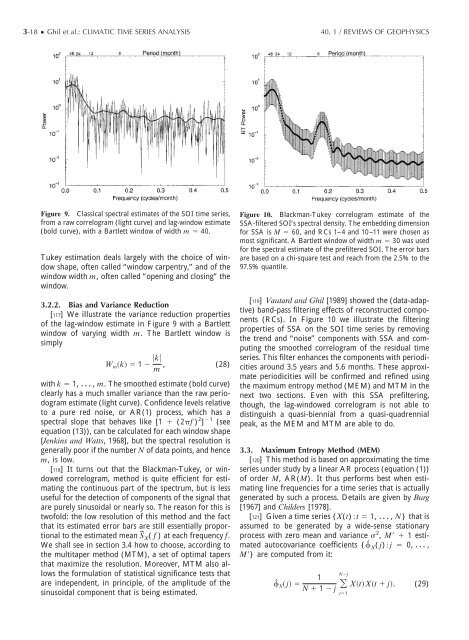advanced spectral methods for climatic time series - Atmospheric ...
advanced spectral methods for climatic time series - Atmospheric ...
advanced spectral methods for climatic time series - Atmospheric ...
Create successful ePaper yourself
Turn your PDF publications into a flip-book with our unique Google optimized e-Paper software.
3-18 ● Ghil et al.: CLIMATIC TIME SERIES ANALYSIS 40, 1 / REVIEWS OF GEOPHYSICS<br />
Figure 9. Classical <strong>spectral</strong> estimates of the SOI <strong>time</strong> <strong>series</strong>,<br />
from a raw correlogram (light curve) and lag-window estimate<br />
(bold curve), with a Bartlett window of width m 40.<br />
Tukey estimation deals largely with the choice of window<br />
shape, often called “window carpentry,” and of the<br />
window width m, often called “opening and closing” the<br />
window.<br />
3.2.2. Bias and Variance Reduction<br />
[117] We illustrate the variance reduction properties<br />
of the lag-window estimate in Figure 9 with a Bartlett<br />
window of varying width m. The Bartlett window is<br />
simply<br />
Wmk 1 k<br />
, (28)<br />
m<br />
with k 1, , m. The smoothed estimate (bold curve)<br />
clearly has a much smaller variance than the raw periodogram<br />
estimate (light curve). Confidence levels relative<br />
to a pure red noise, or AR(1) process, which has a<br />
<strong>spectral</strong> slope that behaves like [1 (2f ) 2 ] 1 (see<br />
equation (13)), can be calculated <strong>for</strong> each window shape<br />
[Jenkins and Watts, 1968], but the <strong>spectral</strong> resolution is<br />
generally poor if the number N of data points, and hence<br />
m, is low.<br />
[118] It turns out that the Blackman-Tukey, or windowed<br />
correlogram, method is quite efficient <strong>for</strong> estimating<br />
the continuous part of the spectrum, but is less<br />
useful <strong>for</strong> the detection of components of the signal that<br />
are purely sinusoidal or nearly so. The reason <strong>for</strong> this is<br />
twofold: the low resolution of this method and the fact<br />
that its estimated error bars are still essentially proportional<br />
to the estimated mean S˜ X( f ) at each frequency f.<br />
We shall see in section 3.4 how to choose, according to<br />
the multitaper method (MTM), a set of optimal tapers<br />
that maximize the resolution. Moreover, MTM also allows<br />
the <strong>for</strong>mulation of statistical significance tests that<br />
are independent, in principle, of the amplitude of the<br />
sinusoidal component that is being estimated.<br />
Figure 10. Blackman-Tukey correlogram estimate of the<br />
SSA-filtered SOI’s <strong>spectral</strong> density. The embedding dimension<br />
<strong>for</strong> SSA is M 60, and RCs 1–4 and 10–11 were chosen as<br />
most significant. A Bartlett window of width m 30 was used<br />
<strong>for</strong> the <strong>spectral</strong> estimate of the prefiltered SOI. The error bars<br />
are based on a chi-square test and reach from the 2.5% to the<br />
97.5% quantile.<br />
[119] Vautard and Ghil [1989] showed the (data-adaptive)<br />
band-pass filtering effects of reconstructed components<br />
(RCs). In Figure 10 we illustrate the filtering<br />
properties of SSA on the SOI <strong>time</strong> <strong>series</strong> by removing<br />
the trend and “noise” components with SSA and computing<br />
the smoothed correlogram of the residual <strong>time</strong><br />
<strong>series</strong>. This filter enhances the components with periodicities<br />
around 3.5 years and 5.6 months. These approximate<br />
periodicities will be confirmed and refined using<br />
the maximum entropy method (MEM) and MTM in the<br />
next two sections. Even with this SSA prefiltering,<br />
though, the lag-windowed correlogram is not able to<br />
distinguish a quasi-biennial from a quasi-quadrennial<br />
peak, as the MEM and MTM are able to do.<br />
3.3. Maximum Entropy Method (MEM)<br />
[120] This method is based on approximating the <strong>time</strong><br />
<strong>series</strong> under study by a linear AR process (equation (1))<br />
of order M, AR(M). It thus per<strong>for</strong>ms best when estimating<br />
line frequencies <strong>for</strong> a <strong>time</strong> <strong>series</strong> that is actually<br />
generated by such a process. Details are given by Burg<br />
[1967] and Childers [1978].<br />
[121] Given a <strong>time</strong> <strong>series</strong> {X(t)t 1, , N } that is<br />
assumed to be generated by a wide-sense stationary<br />
process with zero mean and variance 2 , M 1 estimated<br />
autocovariance coefficients {ˆ X( j)j 0, ,<br />
M} are computed from it:<br />
Nj<br />
1<br />
ˆ X j Xt Xt j. (29)<br />
N 1 j<br />
t1






